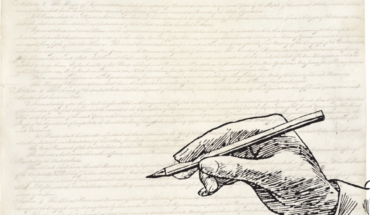A visit to the nation’s coveted museum reminds us of its history
BY MELANIE JENSEN, STAFF WRITER
On Constitution Ave. in Washington, D.C., between the White House and the U.S. Capitol, three of the most influential documents in American democracy sit on display in a dimly lit rotunda.
The National Archives Museum is home to the U.S. Constitution, the Declaration of Independence and the Bill of Rights. It also holds more than 750,000 artifacts, 41 million photographs and 12.5 billion pieces of paper. Some archives rest in the storage facilities built into the museum in 1937, while others are on display for visitors to explore for free.
The Charters of Freedom exhibition hosts the U.S. Constitution, the Bill of Rights and the Declaration of Independence in a spacious rotunda on the second floor, adorned with two curved murals commissioned by artist Barry Faulkner in 1934.
The mural on the left depicts the Founding Fathers presenting the Declaration of Independence to John Hancock, while the mural on the right shows James Madison submitting the Constitution to George Washington.
The room remains dimly lit to prevent damaging the over 200-year-old documents, and security guards enforce a strict no-flash photography policy. On the edges of the curved room, encased exhibits provide historic context for each document.
While the Charters of Freedom exhibit is the most popular, the Records of Rights exhibition houses the most artifacts. Located directly across the museum entrance in the David M. Rubenstein Gallery, this exhibition focuses on three major themes in U.S. history: African American rights, women’s rights and immigrant rights.
Near the entrance of the gallery, one of four original copies of the 1297 Magna Carta is on display. This document, which limited the king’s power in England and granted individual rights to the people, later inspired the Founding Fathers while drafting the Declaration of Independence. At the center of the gallery, a 17-foot touchscreen table allows visitors to interact with other archived documents related to privacy rights, workplace rights, Native American rights and more.
To the left of the table, Private Cato Greene’s discharge papers from the Continental Army in 1783 sit brightly lit. Greene was an enslaved Revolutionary War soldier who fought to earn his freedom. His experience highlights the long struggle for Black Americans to be included in the Declaration of Independence’s statement “all men are created equally.”
The exhibition also features documents related to women’s marriage rights, financial freedoms, equal pay and reproductive rights. A 1917 petition from the Women Voters Anti-Suffrage Party of New York, signed by 17 women, illustrates the complex history of women’s suffrage. Not all women supported the right to vote.
“Our country in this hour of peril should be spared the harassing of its public men and the distracting of its people from work for the war,” the petition reads. The party sent the petition to the Senate, urging lawmakers to avoid such a “radical change” while the nation was engaged in World War I.
Similar to the struggles faced by African Americans and women, the Records of Rights exhibition displays the historic support and opposition to immigrants’ rights.
“Holding high the flame of hope in New York Harbor, the Statue of Liberty has welcomed generations of immigrants and became an icon for freedom,” a display reads. The 1884 Deed of Gift from France,which transferred ownership of the Statue of Liberty to the United States, serves as an ever-lasting symbol of immigration history in America.
While the Records of Rights exhibition showcases the unbending fight for freedom and liberty throughout U.S. history, rotating exhibitions like Power and Light offer a glimpse into the lives of families at a specific point in time. Russell Lee’s 1946 Coal Survey features more than 200 photographs of coal miners and their families in West Virginia, Kentucky, Utah and other states.
The enlarged portraits show miners at work and with their families at home, illustrating their daily lives and labor struggles in the years following World War II.
Beyond its historic artifacts, the museum’s architecture enhances its storytelling. Architect John Russel Pope chose the location in between the Capitol and the White House to emphasize its symbolic importance. The museum’s grand Corinthian columns and intricate pediments with allegorical sculptures sit atop the museum’s carved name adding to its significance.
An inscription on the west side of the building reminds passersby of the museum’s core mission:“The glory and romance of our history are here preserved in the chronicles of those who conceived and builded the structure of our nation.” This message underscores the institution’s role in safeguarding the nation’s historic legacy.
The National Archives Museum serves as a living testament to American democracy, preserving and displaying the country’s significant documents and historical records for future generations.



